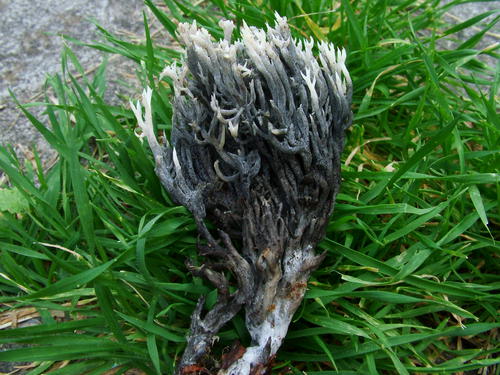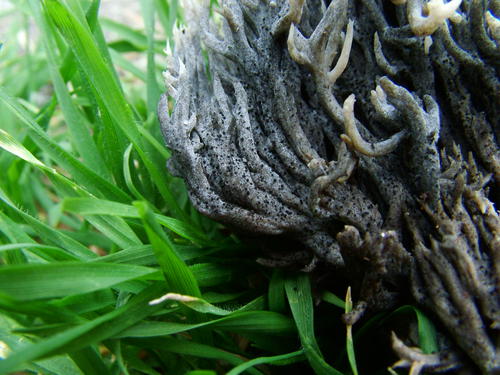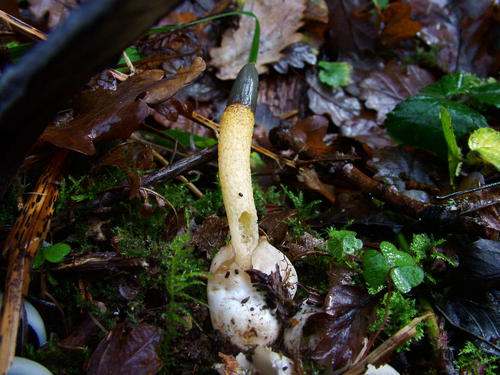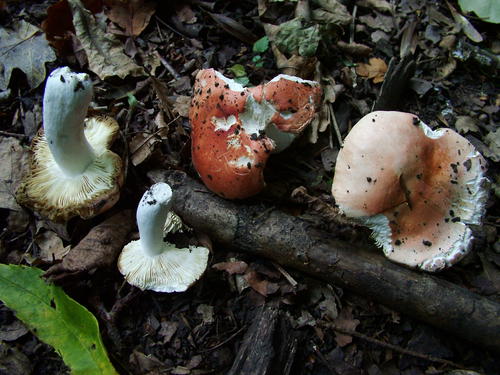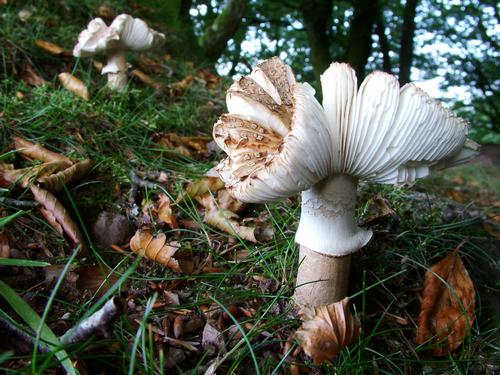Fungus forays at Monkwood Nature Reserve, near Hallow, Worcestershire
Justin Smith
justinhongos@yahoo.co.uk
Worcestershire Naturalists’ Society (WNS) organised fungus forays at Monk Woods Nature Reserve in October 2010, and earlier in the decade, in October 2004. The site is a well known butterfly reserve, but has been well known to the WNS as both a botanically-rich and mycologically-rich site; certainly Carleton Rea recorded there regularly over 100 years ago. Rea recorded common species such as Lactarius pyrogalus, Russula nigricans and Amanita citrina and also unusual species such as Cortinarius acutus and Asterophora parasitica (on Russula nigricans) which all turned up on the 2010 foray. Incidentally, Rea regarded Asterophora parasitica (as Nyctalis parasitica) as common, though it is now a species that has to be searched for even if the host is common.
The 2010 foray turned up 110 species, an excellent figure for a public even. I remember leading forays in the early-mid 1980s, and this figure was the norm for many ‘good’ sites; the average for a diverse site is now normally 50-80 species, depending on time forayed, number of attendees etc. Much of the species richness for a site can be attributed to prevailing weather conditions during the main fungus fruiting season; September-November; if it is wet and warm enough, it will be a ‘good’ season; in fact, over the last 15 years, no fungus season has been the same. Most have been too dry, but some years have been damp and warm; those years have been excellent fungus recording years; 1997, 2004 and 2010 were the most memorable. Incidentally, the previous Monk Woods foray in 2004, in one of the ‘good’ years, produced 112 species over roughly the same time and area as the 2010 foray.
Monk Woods itself is botanically diverse site, dominated by oaks, hazel, ash, birch and in places by beech, willow or alder; there is a well developed under-storey dominated by hazel, with some patchy blackthorn, all on a relatively level site, divided by ditches, on clayey soils, which vary in acidity throughout the wood. The diversity of tree and shrub species in turn produce a diverse mycota of both saprotrophs (litter and dead wood feeding) and mycorrhizal (symbiotic) species.
In all, in 2010, over 50% species recorded are mycorrhizal and typified by representatives of the genera Cortinarius, Inocybe, Amanita, Lactarius, Russula and Tricholoma among others. Around 35% of species recorded in 2004 are mycorrhizal. Of the 2010 mycorrhizal species, most are common throughout the UK, but Amanita submembranacea, Russula velenovskyi, Russula farinipes and Otidea bufonia are under-recorded. A beautiful pair of clusters of the latter were found close to the car park. Star finds were Cortinarius parvannulatus and C. alnetorum, both recorded in less than 20 sites in the UK. One assumes, that as they are LBJs (Little Brown Jobs), they are likely to have been purely overlooked elsewhere. Ripartites tricholoma, another potential mycorrhizal species, appears on the 1991 RDB list for the UK, and was recorded in Monk Woods in both 2004 and 2010. Of the other 2004 mycorrhizal species recorded, Russula pseudointegra, Lepiota grangei and Tephrocybe rancida are all under-recorded in the UK.
Of the saprotrophs, the star find was Entoloma byssisedum, known from single locations in eight counties in England. It is probably overlooked, but distinct, as it tends to grow closely attached, and often under bark, on deciduous branches. It was found on both bramble and hazel in 2010. Unlike the superficially similar genus Crepidotus, the fruit-body is sessile on host material, but the spores are angular-nodulose, as opposed to ellipsoid-subglobose as typically found in Crepidotus. Other saprotrophs of note include Clitocybe candicans, Typhula phacorrhiza and Abortiporus biennis. One parasitic fungus which turned up in 2004 and 2010, forming dark greyish lesions and tiny black perithecia on Clavulina cinerea, was Helminthosphaeria clavariarum (see photos).
Edible fungi were in profusion, but almost entirely dominated by Horn of Plenty growing in droves in mixed oak-hazel areas.
It is envisaged that the WNS will hold further forays at Monk Woods in the future, and hopefully this will coincide with one of the ‘good’ years!
References
Amphlett, J. & Rea, C. 1909. The Botany of Worcestershire (Re-issue EP Publishing 1978)
Brandrud, T.E., Linstrom, H., Marklund, H., Melot, J. & Muskos, S. 1990-2001. Cortinarius Flora Photographica Volumes 1-4 (Photoflora)
Ellis, M.B. & Ellis, J.P. 1998. Micro-fungi on Miscellaneous Substrates (Richmond Publishing)
Evans, S. 2005. Red Data List for Threatened British Fungi: Provisional Assessment www.fieldmycology.net/download/RDL_of_Threatened_British_Fungi.pdf
Galli, R. 1996. Le Russule (Edizioni Edinatura)
Ing, B. 1991. Provisional Red Data List of British Fungi: The Mycologist 6 (3) Pp 124-128
Kirby, G. 2007. The Genus Russula in Great Britain with Synoptic Keys to Species (Self Published)
Legon, N.W. & Henrici, A. 2005. Checklist of the British and Irish Basidiomycota (Kew Publications) + 2007/2008/2009 updates.
Neville, P. & Poumarat, S. 2004. Amaniteae; Amanita, Limacella & Torrendia; Fungi Europaei; Part 9 (Edizioni Candusso)
Noordeloos, M.E., Vellinga, E. & Kuyper, T.W. 1998. Flora Agaricina Neerlandica; Volume 1: Entolomataceae (Balkema)
Noordeloos, M.E. 1992 + 2004. Entoloma sensu lato: Fungi Europaei; Parts 5 & 5A (Edizioni Candusso)
Images
Fig. 1. Parasitic fungus Helminthosphaeria clavariarum on Clavulina cinerea. Anonymous
Fig. 2. Parasitic fungus Helminthosphaeria clavariarum on Clavulina cinerea. Anonymous
Fig. 3. Mutinus caninus. Anonymous
Fig. 4. Russula pseudointegra. Anonymous
Fig. 5. The Blusher Amanita rubescens. Anonymous
